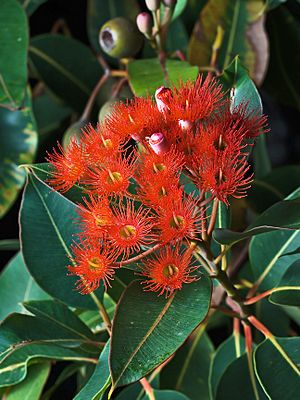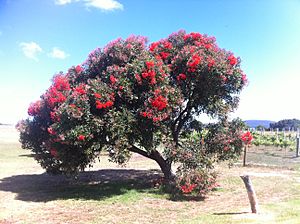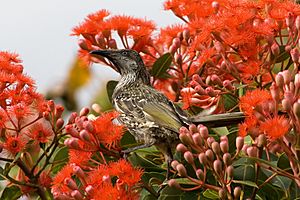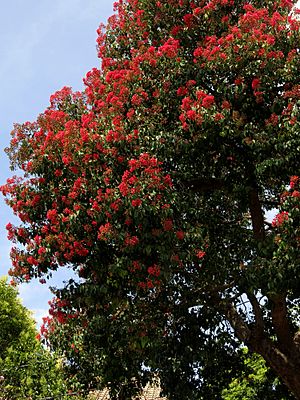Red flowering gum facts for kids
Quick facts for kids Red flowering gum |
|
|---|---|
 |
|
| Corymbia ficifolia in flower. | |
| Scientific classification | |
| Genus: |
Corymbia
|
| Species: |
ficifolia
|
| Synonyms | |
|
|



The Corymbia ficifolia, also known as the red flowering gum, is a special type of small tree. It is found only in the south-west part of Western Australia. This tree has rough, stringy bark on its trunk and branches. Its leaves are shaped like eggs or wide spears.
The red flowering gum is famous for its bright red, pink, or orange flowers. These flowers grow in groups of seven. After the flowers, it produces fruit shaped like urns. Even though it doesn't grow in many places naturally, it's one of the most popular eucalyptus trees planted in gardens and streets around the world.
Contents
What Does the Red Flowering Gum Look Like?
The red flowering gum is a tree that usually grows up to 10 meters (about 33 feet) tall. It has rough, brownish bark that feels like fibers. This bark covers both the trunk and the branches.
Its adult leaves are a bit dull or slightly shiny. They are lighter on the underside. These leaves are shaped like eggs or wide spears. They are about 7 to 13 centimeters (3 to 5 inches) long and 2.5 to 5 centimeters (1 to 2 inches) wide. Each leaf has a small stem called a petiole that connects it to the branch.
The tree's flower buds grow at the ends of its branches. They are arranged on a main stalk called a peduncle, which is about 1.5 to 3.2 centimeters (0.6 to 1.3 inches) long. Each part of this stalk holds seven buds. These buds are on smaller stems called pedicels, which are about 1.3 to 2.7 centimeters (0.5 to 1.1 inches) long.
The mature buds are oval or pear-shaped. They are about 1.2 to 1.8 centimeters (0.5 to 0.7 inches) long and 0.6 to 0.8 centimeters (0.2 to 0.3 inches) wide. They have a rounded or flat cap called an operculum.
The red flowering gum blooms from December to May. Its flowers can be bright red, pink, or orange. After flowering, the tree produces a woody, urn-shaped fruit. This fruit is a capsule about 2 to 4.2 centimeters (0.8 to 1.7 inches) long and 1.8 to 3 centimeters (0.7 to 1.2 inches) wide. The seed compartments are hidden inside the fruit.
There are two other similar trees in Western Australia: the mountain marri (C. haemotoxylon) and the marri (C. calophylla). These trees have bark that looks like a checkerboard, which is different from the fibrous bark of the red flowering gum.
How Was This Tree Named?
The red flowering gum was first officially described in 1860 by a scientist named Ferdinand von Mueller. He called it Eucalyptus ficifolia. He wrote about it in his book, Fragmenta Phytographiae Australiae. Later, in 1995, two other scientists, Ken Hill and Lawrence Alexander Sidney Johnson, changed its name to Corymbia ficifolia.
The name ficifolia comes from two Latin words: ficus, meaning "fig," and folium, meaning "a leaf." This name was chosen because the leaves of the red flowering gum look similar to the leaves of some fig trees.
Where Does the Red Flowering Gum Grow?
The Corymbia ficifolia grows in sandy soil in low forests. It prefers slopes. You can find it in a small area along the coast south-east of Perth. This area stretches east of Mount Frankland, Walpole, and the Stirling Range.
How We Use This Tree
The red flowering gum is one of the most popular eucalyptus trees planted around the world, not just in Australia. It grows best in places with mild weather and not much rain in summer. It doesn't do well in very cold places or very wet tropical areas.
In good climates, it grows fairly quickly. Sometimes, it grows even bigger and stronger when planted than it does in the wild. It's hard to grow eucalyptus trees from cuttings, so they are usually grown from seeds. This means you can't always be sure what color the flowers will be. However, some smaller types are now available as "grafted plants," which means they are grown by joining parts of two different plants together to ensure a specific flower color.
Naturally, Corymbia ficifolia likes poor, sandy soils. But it can adapt to most mild climates as long as it's not exposed to very harsh frost or constant tropical dampness. It's a great tree for planting along streets because it's tough, grows at a good speed, and usually doesn't get so big that it needs a lot of trimming.
The largest known red flowering gum tree with a single trunk is in Hamilton, New Zealand. It measures about 216.5 centimeters (over 7 feet) across! Scientists are also trying to make this tree more resistant to cold. For example, in Dublin, Ireland, they are collecting seeds from the coldest parts of Australia where it grows. Many plants there died from severe frosts, but the ones that survived are being grown using a special method called tissue culture. This method helps grow new plants from tiny pieces of the original plant.
Gallery
- Features of the red-flowering gum (Corymbia ficifolia)
See also
 In Spanish: Eucalipto de flores rojas para niños
In Spanish: Eucalipto de flores rojas para niños






